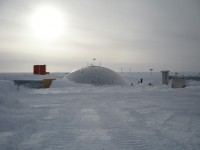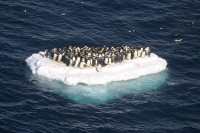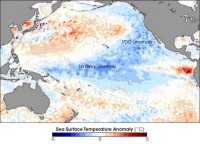
|
Jul 23, 2008
Fossil Suggests Antarctica Much Warmer in Past
By Andrea Thompson, Live Science
A college student’s new discovery of fossils collected in the East Antarctic suggests that the frozen polar cap was once a much balmier place. The well-preserved fossils of ostracods, a type of small crustaceans, came from the Dry Valleys region of Antarctica’s Transantarctic Mountains and date from about 14 million years ago. The fossils were a rare find, showing all of the ostracods’ soft anatomy in 3-D. The fossils were discovered by Richard Thommasson during screening of the sediment in research team member Allan Ashworth’s lab at North Dakota State University. Because ostracods couldn’t survive in the current Antarctic climate, their presence suggests that the southern-most continent hasn’t always been as frigid as it is today.
“Present conditions in this Antarctic region show mean annual temperatures of minus 25 degrees C (Celsius) [minus 13 degrees Fahrenheit],” said Mark Williams of the University of Leicester, co-author with Ashworth of the fossil-find report in the journal Proceedings of the Royal Society B. “These are impossible conditions to sustain a lake fauna with ostracods.”
Marchant estimated that the summer temperatures in Antarctica would have been about 30.6 degrees F (17 degrees C) warmer than they are now.
This warmer period started to end when the first continent-sized ice sheets began appearing on Antarctica around 34 million years ago, around the end of the Eocene epoch. These ice sheets expanded and contracted until around 14 million years ago, during the Miocene epoch, when a dramatic cooling took place and transformed the tundra into an environment “that today looks like Mars,” Marchant told LiveScience.

See South Pole Amundsen Scott Station. See larger image here. Lows on July 21 and 22 were -88F.
Marchant said climatologists are uncertain exactly what caused this intense period of cooling. Read more here. Note the answer likely is “what you see when you look up on a cloudless day”.
Jul 23, 2008
Opinion: Global Warming’s Fatal Flaw?
The Daily Bayonet
I believe that human nature will finally kill off the global warming hoax, delivering a coup de grace to the damage already wrought on the hoaxers schemes by the economy. Let me explain my theory. For many years now we`ve been bombarded with the increasingly shrill message of the leader of the global warming death cult, Al Gore, telling us that we needed to change our behaviour and save the planet, even while his own behaviour belied the fact that there was any impending planetary emergency. This was all well and good with gas prices at $2/gallon. People were happy to eat up the climate change message, without really thinking about it, while the required behavioural changes had little real impact on their daily lives.
However, I no longer believe this to be the case. Now questions are being asked by increasingly prominent voices, with increasing regularity. Major media is asking questions about both the science and the motivations of the people driving the global warming agenda. Al Gore controls access to his public appearances to eliminate any chance that he might get an awkward question. He recently committed $300 million to advertise the global warming agenda. Two years ago he wouldn’t have believed such am expense would have been needed, such was the ruthless efficiency of the pro-warming activists. The real difference between these times that for convenience I will call ‘then’ and ‘now’ is that the global warmers have made adherence to their code inconvenient for the average person. Behaving in a green manner now comes at a real, often imposed, cost.
Human nature is not to go quietly into the night, at least not without good reason. And the more people look into the cult of global warming, they see fewer reasons to comply with the notion that we must change the way we live. The planet is not in peril; the polar bears are breeding like rabbits, arctic ice tends to melt in the summertime and there is a lot more Antarctic ice than there used to be. The climate’s changing, sure - but that’s what climate does, live with it and enjoy the sunshine. Global warming has crossed a line in the mind of many; the increasingly totalitarian voice of the the warmers combined with the real costs and inconveniences delivered by their policies and demands are causing people to ask awkward questions of the warmers. When they see what the real answers are, they will reject the hoax and continue on as before, but with a wary eye on the next generation of alarmists and social engineers.
It’s human nature, and it might just save us. Read the full post here.
Jul 21, 2008
Nutty Story of the Day: “Global Warming” is Killing the Penguins in Antarctica
By Anthony Watts, Watts Up With That
You have to wonder how the press allows stories like these to get published without some basic fact checking. I’m reminded of the recent CBS News story about “resonance” and global warming causing more earthquakes.
From the UK Sunday Mirror: Plight of the p-p-p penguins
By Richard Cooper 20/07/2008
This shivering penguin is just one of thousands close to death in Antarctica. Rain storms have killed tens of thousands of chicks - and scientists blame global warming. New-born penguins take 40 days to grow water-proof feathers. They can withstand snow, but if rain soaks them to the skin, they die of cold. Experts yesterday said 400 Adelie penguin chicks have washed up dead on Brazil’s beaches after migrating 2,500 miles to avoid the rain. The Emperor penguin - star of the hit film March Of The Penguins - is also under threat. Antarctic temperatures have risen by 3C in the last 50 years to an average of - 14.7C (5.5F). The penguin population has fallen by up to 80 per cent and, if the downpours go on, they will be extinct within 10 years. Dozens of migrant penguins are being treated at Rio de Janeiro’s Niterio Zoo. Biologist Erli Costa said: “This is all due to global warming.”
That’s the entire story, no other sources are given. But I did find the source Associated Press story here. Interestingly, the AP story has no mention of “rain” or of “baby chick penguins”. There were mentions of other causes such as food supply and pollution as possible causes.

At the very least, let’s check the temperature in Antarctica, It’s winter there. Hmmm. Warmest temperature is -6C (21F), it is rather difficult to get rain under that sort of temperature. Unfortunately I did not find an easy to decipher archive of temperatures for the last few days, but again given it is winter there, the prospect of above freezing air temperatures seems unlikely. (Icecap Note, Amundsen-Scott AFB at the South Pole had an overnight low of -88F)
And then there is this statement from the story: “Experts yesterday said 400 Adelie penguin chicks have washed up dead on Brazil’s beaches after migrating 2,500 miles to avoid the rain.” Huh? But here is the clincher from the AP story: “Costa said the vast majority of penguins turning up are baby birds that have just Experts yesterday said 400 Adelie penguin chicks have washed up dead on Brazil’s beaches after migrating 2,500 miles to avoid the rain.” left the nest and are unable to out-swim the strong ocean currents they encounter while searching for food.” Mr. Cooper, your story is all wet. The Mirror should issue a retraction. Read more here. Be sure and see the third comment by our friend, Eugenio Hackbart of the Brazilian Metsul:
Dear Anthony,
I am astonished by this part of the Sunday Mirror article you reproduced. This is a complete absurd. I cannot stress in words how false this information is. I am a 71-year old man that has been working in weather forecast for decades. My initial graduation was Biology. Penguins always, I repeat always, came ashore in our coast during this time of this year. They migrate to seek food. Many are young and do not resist. They perform in a “food marathon”, taking a “ride” in the Malvinas/Falklands sea current. This time of the year the current is stronger and closer to the shore. Many of them do not resist and are taken to the sand. Some come ashore already dead, but many are rescued alive and treated in centers dedicated to oceanography. The growing menace to penguins in our shores are fishing and oil spills from boats in the sea.” Eugenio has more to say. Check it out.
Jul 19, 2008
Shifting of the PDO to Cool Mode Assures Global Cooling for the Next Three Decades
Don J. Easterbrook, Dept. of Geology, Western Washington University, Bellingham, WA
Addressing the Washington Policymakers in Seattle, WA, Dr. Don Easterbrook said that shifting of the Pacific Decadal Oscillation (PDO) from its warm mode to its cool mode virtually assures global cooling for the next 25-30 years and means that the global warming of the past 30 years is over. The announcement by NASA that the (PDO) had shifted from its warm mode to its cool mode is right on schedule as predicted by past climate and PDO changes (Easterbrook, 2001, 2006, 2007) and is not an oddity superimposed upon and masking the predicted severe warming by the IPCC. This has significant implications for the future and indicates that the IPCC climate models were wrong in their prediction of global temperatures soaring 1F per decade for the rest of the century.

Cooling of the Pacific Ocean and setting up of the cool-mode PDO. Sea surface temperature anomaly in the Pacific Ocean from April 14-21, 2008. See larger image here.
The cool water anomaly in the center of the image shows the lingering effect of the year-old La Nina. However, the much broader area of cooler-than-average water off the coast of North America from Alaska (top center) to the equator is a classic feature of the cool phase of the Pacific Decadal Oscillation (PDO). The cool waters wrap in a horseshoe shape around a core of warmer-than-average water. (In the warm phase, the pattern is reversed). Unlike El Nino and La Nina, which may occur every 3 to 7 years and last from 6 to 18 months, the PDO can remain in the same phase for 20 to 30 years.
As shown by the historic pattern of PDOs over the past century and by corresponding global warming and cooling, the pattern is part of ongoing warm/cool cycles that last 25-30 years. Each time the PDO mode has shifted from warm to cool or cool to warm, the global climate has changed accordingly. In 1977, the PDO shifted from cool mode to warm mode and set off the global warming from 1977 to 1998, often referred to as the “Great Climate Shift.” The recent shift from PDO warm mode to cool mode is similar to the shift that occurred in the mid-1940’s and resulted in 30 years of global cooling. The global warming from ~1915 to ~1945 was also brought on by a mode shift in the PDO. Every indication points continuation of the PDO patterns of the past century and global cooling for the next 30 years. Thus, the global warming the Earth has experienced since 1977 appears to be over!

See larger image here.
See full story here.
Jul 18, 2008
Russian Scientists Deny Kyoto Protocol Reflects a Consensus View of the World Scientific Community
By Vladimir Radyuhin, Hindu.com
As western nations step up pressure on India and China to curb the emission of greenhouse gases, Russian scientists reject the very idea that carbon dioxide may be responsible for global warming. Russian critics of the Kyoto Protocol, which calls for cuts in CO2 emissions, say that the theory underlying the pact lacks scientific basis. Under the Theory of Anthropogenic Global Warming, it is human-generated greenhouse gases, and mainly CO2, that cause climate change. “The Kyoto theorists have put the cart before the horse,” says renowned Russian geographer Andrei Kapitsa. “It is global warming that triggers higher levels of carbon dioxide in the atmosphere, not the other way round.”
Russian researchers made this discovery while studying ice cores recovered from the depth of 3.5 kilometres in Antarctica. Analysis of ancient ice and air bubbles trapped inside revealed the composition of the atmosphere and air temperature going back as far as 400,000 years. “We found that the level of CO2 had fluctuated greatly over the period but at any given time increases in air temperature preceded higher concentrations of CO2,” says academician Kapitsa, who worked in Antarctica for many years. Russian studies showed that throughout history, CO2 levels in the air rose 500 to 600 years after the climate warmed up. Therefore, higher concentrations of greenhouse gases registered today are the result, not the cause, of global warming.
The hypothesis of anthropogenic greenhouse gases was born out of computer modelling of climate changes. Russian scientists say climate models are inaccurate since scientific understanding of many natural climate factors is still poor and cannot be properly modelled. Oleg Sorokhtin of the Russian Academy of Sciences Institute of Ocean Studies, and many other Russian scientists maintain that global climate depends predominantly on natural factors, such as solar activity, precession (wobbling) of the Earth’s axis, changes in ocean currents, fluctuations in saltiness of ocean surface water, and some other factors, whereas industrial emissions do not play any significant role. Moreover, greater concentrations of CO2 are good for life on Earth, Dr. Sorokhtin argues, as they make for higher crop yields and faster regeneration of forests. “There were periods in the history of the Earth when CO2 levels were a million times higher than today, and life continued to evolve quite successfully,” agrees Vladimir Arutyunov of the Russian Academy of Sciences Institute of Chemical Physics. Read more here.
|
|
|
|






